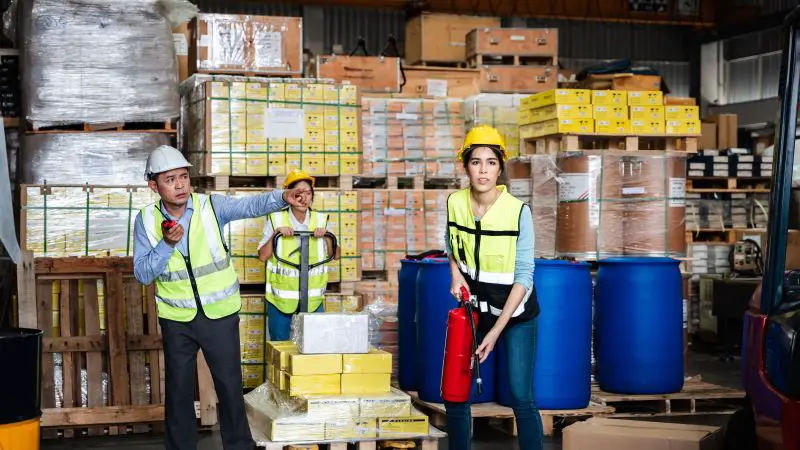Click here to get this post in PDF

Workplaces across Australia, from offices and warehouses to construction sites and retail spaces, all present potential hazards that can affect employees’ health, safety, and productivity. While some risks are obvious—like heavy machinery or hazardous chemicals—others can be far more subtle, such as poor ergonomics or ineffective communication systems. Employers have both a legal and ethical responsibility to identify these hazards and take proactive steps to mitigate them.
With advancements in workplace safety technology, businesses can also partner with innovative providers like Speedshield Technologies to reduce risks and improve safety outcomes across industries. Ultimately, prevention comes down to awareness, planning, and ongoing training.
Below, we explore some of the most common workplace hazards and outline practical strategies for preventing them.
Slips, Trips, and Falls
- Keep walkways clear of obstacles and properly lit.
- Use slip-resistant flooring or mats in high-traffic areas.
- Display clear signage when floors are wet or undergoing cleaning.
- Encourage staff to wear appropriate footwear.
- Conduct regular housekeeping checks to maintain tidy, hazard-free spaces.
Manual Handling Injuries
- Provide manual handling training that emphasises safe lifting techniques.
- Invest in mechanical aids such as trolleys, forklifts, or pallet jacks.
- Rotate tasks to reduce repetitive strain injuries.
- Encourage employees to ask for assistance when moving heavy loads.
Ergonomic Hazards
- Ensure workstations are adjustable to fit the individual.
- Provide ergonomic chairs, desks, and accessories such as keyboard trays.
- Encourage staff to take short, regular breaks to stretch and move.
- Offer guidance on correct posture and workstation setup.
Electrical Hazards
- Regularly inspect and test electrical equipment.
- Ensure only qualified electricians handle installations and repairs.
- Avoid overloading power outlets and extension cords.
- Provide clear procedures for reporting faulty equipment.
Fire Hazards
- Install and maintain fire detection and suppression systems.
- Store flammable substances in designated areas with proper labelling.
- Train staff in emergency evacuation procedures.
- Carry out regular fire drills to ensure preparedness.
Chemical Hazards
- Provide proper storage facilities and ensure chemicals are clearly labelled.
- Train employees on handling procedures and emergency responses.
- Supply appropriate personal protective equipment (PPE), such as gloves and respirators.
- Keep Material Safety Data Sheets (MSDS) accessible.
Noise Hazards
- Monitor noise levels and assess risk in noisy areas.
- Provide hearing protection such as earmuffs or earplugs.
- Rotate workers between noisy and quieter tasks.
- Maintain machinery to reduce unnecessary noise.
Vehicle and Machinery Hazards
- Train operators thoroughly and require certification.
- Implement speed control and collision-avoidance systems.
- Carry out regular equipment maintenance and safety checks.
- Establish clear traffic management plans and pedestrian zones.
Psychological Hazards
- Foster an open, supportive workplace culture.
- Encourage employees to raise concerns without fear of reprisal.
- Provide access to employee assistance programs (EAPs).
- Ensure workloads are realistic and adequately resourced.
- Train managers to recognise signs of stress and respond appropriately.
Poor Communication
- Establish clear safety policies and procedures.
- Use signage and visual cues in high-risk areas.
- Conduct regular safety briefings and toolbox talks.
- Encourage employees to speak up about hazards or unsafe practices.
Building a Safer Workplace
Preventing workplace hazards requires more than a checklist—it’s about creating a culture of safety where everyone understands their role. Employers must remain proactive by:
- Conducting regular risk assessments.
- Involving employees in safety planning.
- Staying up to date with safety regulations and technology.
- Continuously reviewing and improving safety practices.
Every workplace, regardless of size or industry, faces potential hazards
The difference between a safe environment and one prone to incidents lies in the systems, training, and culture established by employers. From slips and falls to psychological stressors, each hazard requires careful planning and prevention strategies. With the support of innovative partners, businesses can take workplace safety to the next level—protecting not only their staff but also their reputation and long-term success.
Also read:
Preventing the Fall: Innovative Strategies for Businesses to Mitigate Slip and Fall Risks
Managing Trip Hazards In A Warehouse: 9 Tips For Conscientious Employers
Image source: elements.envato.com
